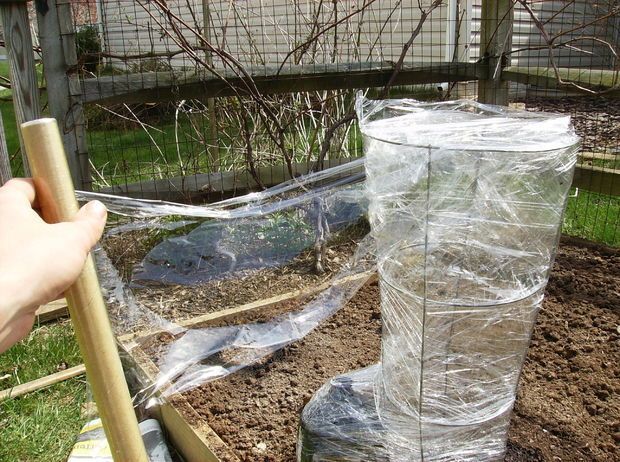1. Insulate tomatoes with plastic wrap
Tomatoes thrive in stagnant, hot weather. So if the weather in your area is neither. It takes extra effort to make warm weather plants produce fruit.
Wrapping the bottom two rungs of the tomato cage with plastic wrap simulates a greenhouse. The heat is trapped inside the plastic wrap and the plants are blocked from the wind. By the time the plants reach the top of the plastic wrap, they’re strong plants and well adjusted to the temperatures and wind!
How To Do It: Have a small helper hold the end of the plastic wrap onto a vertical stake with two hands. Wrap the plastic wrap around one full time, and then continue wrapping around as you work your way down or up the cage (we started at the top and worked down). Be sure to wrap at least two layers to get the full effect and make the plastic wrap stick to itself. I used the plastic wrap I had in the kitchen, but you might want to consider a 20″ heavy duty plastic wrap if you have several plants to wrap.

2. Insulate smaller plants with milk jugs
It’s the same concept as the tomatoes. Bell peppers, for example, also need warmer weather, so by insulating them with the milk jugs gives them a fighting chance through our cooler springs so maybe, just maybe, they might bear fruit come summer!
How To Do It: Using a pair of scissors, cut off the top and bottom of a used milk jug. Rinse it out well and place it over/around the plant. Be sure to pack a little bit of dirt against the outside edges of the milk jug so that it doesn’t easily knock over when the wind blows.

3. Catch pincher bugs with oil
Also known as earwigs, pincher bugs like to eat the leaves of the plants. Specifically, they’re eating the zucchini plants. They are hungry, vicious little bugs and you have to act fast if you want your plants to survive.
Try the newspaper trick, where you roll up newspaper, get it slightly damp and place it in the garden bed. Then bright and early the next morning you remove the newspaper and dispose of the bugs.
Or you can try to lure them and drown them with oil.
How To Do It: You’ll need an old plastic container with a lid (think yogurt, sour cream or cottage cheese). Using a pair of scissors, cut a oval-shaped hole about 1″ from the top of the container. Repeat this so that there are 4-5 holes in the container. Bury the container in the garden so that the holes are ground level. Fill the container with 3 parts cheap cooking oil to 1 part soy sauce. The bugs will be lured in by the soy sauce and will drown and get stuck in oil. (To help gauge, we used about 3/4 cup oil and 1/4 cup soy sauce for a 32 oz yogurt container.)

4. Deter other bugs with cayenne pepper spray
While the homemade earwig traps are working well, there are still some bugs in the garden that are chomping on leaves (ants?). While the damage isn’t too bad, we’re taking precautionary measures and keeping them away with sticky cayenne pepper spray!
How To Do It: Combine 1 tsp of cayenne pepper with 1 cup of hot water. Stir to dissolve the cayenne as much as possible. Pour into a spray bottle and add about 1 tsp of liquid dish soap. Fill the bottle with water and swish gently to combine (don’t shake otherwise you’ll just make a lot of bubbles). Spray directly onto the leaves of the affected plants. Reapply every 2-3 days, or after watering, or as needed. I recommend getting durable spray bottles that you dedicate just for the garden and keep outside so they’re there when you need them. Otherwise it can be a pain walking back and forth from the garden to the house / garage / shed every time you see a bug.


5. Deep water tomato plants with a broomstick handle
Plants need water down at the roots, and watering at the surface level is fine for most of the time, but tomato plants especially benefit from a really good, deep water every few weeks or so.
How To Do It: Taking the handle of a broom, align it with the edge of the container and plunge it all the way to the bottom. Move the handle in a circular motion until you have a hole that is just a bit bigger than the broom handle. Remove the broom and repeat to make 4-6 holes in the dirt, depending on the size of your pot. Water directly into the hole until the plant is saturated!
6. Fertilize the tomatoes while you’re deep watering
While you’re making deep holes near your tomato plants, go ahead and take advantage by adding a liquid fertilizer to the roots. I make a fertilizer tea for free otherwise I recommend an organic liquid fertilizer.
Source: dontwastethecrumbs.com

